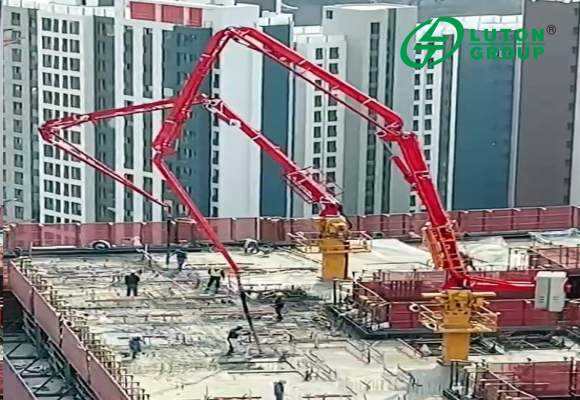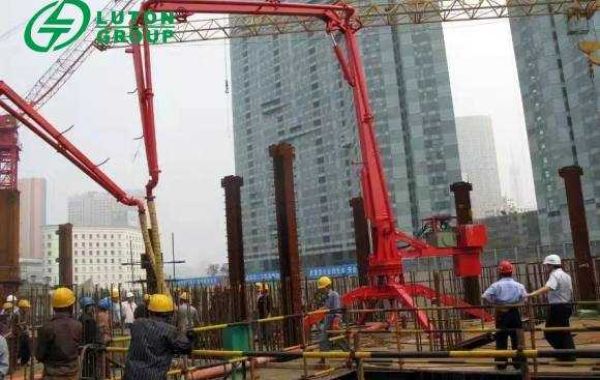With the acceleration of urbanization, high-rise buildings are becoming increasingly common in urban construction. As an important equipment in high-rise building construction, concrete spreaders play an irreplaceable role. This article will explore the application and advantaged and disadvantages of concrete spreaders in high-rise building construction.

Composition and Working Principle of Concrete Distributor
The concrete spider is composed of steel frame support, longitudinal (large vehicle) and transverse (small vehicle) running mechanisms, concrete storage hopper (including screw conveyor, gate device, downward flipping device), safety device, hydraulic system, electrical control system, etc. It mainly achieves precise control and reliable movement of the telescopic arm through the coordination of mechanical and hydraulic systems. The concrete is transported to the end of the spider boom through pipelines, and then evenly laid on the working surface by the feeder.
The concrete feeder can be used in conjunction with the following equipment:
Concrete mixing plant: used to produce qualified concrete and provided for use by fabric feeders.
Concrete transport vehicle: transports concrete from the mixing plant to the location of the feeder.
Concrete pumping equipment, such as concrete towing pumps, concrete pump trucks, etc., mainly delivers concrete to the distributor through high pressure, and then the distributor transports the concrete to higher and farther concrete laying points.
These devices are the basic equipment required for concrete distribution machines in high-rise building construction. Depending on the actual construction needs, other auxiliary equipment and tools may also be needed.
The driving methods of concrete spreaders mainly include the following:
- Hydraulic drive: The rotation and conveying of the fabric feeder are driven by a hydraulic system, which has a large driving force and flexibility, and can adapt to various construction environments and requirements.
- Motor drive: Using a motor as the power source, it drives the rotation and conveying of the fabric feeder through a reducer and transmission device, which has the advantages of high efficiency, energy saving, and low noise.
- Internal combustion engine drive: Using an internal combustion engine as the power source, it drives the rotation and transportation of the fabric feeder through mechanical or hydraulic transmission, suitable for outdoor or construction environments far from power sources.
Different driving methods have their own advantages and disadvantages, and selecting the appropriate driving method needs to be considered based on the actual construction environment and requirements.
The Application of Concrete Spider In High-rise Building Construction
Improving construction efficiency: The concrete feeder has a large conveying capacity and coverage range, which can significantly improve the efficiency of concrete pouring and shorten the construction period.
Reduce labor intensity: Using concrete spreaders can reduce the labor intensity of workers and reduce the difficulty of manual handling and pouring of concrete.
Improving construction quality: The concrete feeder can achieve uniform pouring of concrete, reducing the occurrence of quality problems such as construction cold joints and structural damage.
Strong applicability: The concrete feeder is suitable for the pouring of concrete in various high-rise buildings, especially for the pouring of large volume concrete.
Advantages and Disadvantages of Concrete Spiders
Advantages: Improve construction efficiency, reduce labor intensity, improve construction quality, and reduce the occurrence of quality problems.
Disadvantages: The equipment cost is high, occupies a large space, and requires professional operators and maintenance personnel. (Land on ltconcretepump.com to get more details.)
Conclusion
Concrete spreaders have a wide range of application prospects in high-rise building construction. It can improve construction efficiency, reduce labor intensity, improve construction quality, and reduce the occurrence of quality problems. However, its equipment cost is high, occupies a large space, and requires professional operators and maintenance personnel. In practical applications, the advantages and disadvantages of concrete spreaders should be fully considered, and the equipment should be reasonably selected and used to fully play its role in high-rise building construction.








